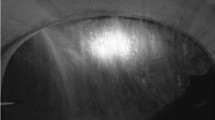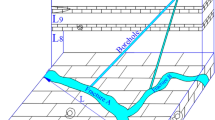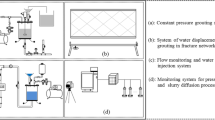Abstract
Grouting is generally applied as an effective way to seal rock fractures, reduce permeability, decrease deformation, increase strength of rocks, and to stop the water flow through the jointed rock mass. But grouting rock fractures under condition of flowing water depends greatly on experiences of professional engineers, without sufficient theoretical guidance to refer to, as no commonly accepted and reasonable theoretical models are available. To describe the grouting process of fractures in flowing water, and put forward reasonable grouting guidance suggestions. The present work established a theoretical model for grouting into a fracture with flowing water. Considering boundary conditions, a streamline equation of grouting diffusion trajectory with flowing water was derived, and analyzed the influence of boundary effect on grouting diffusion law. The simulation tests of grouting rock fracture with flowing water were carried out on the self-developed fracture grouting experimental platform, and the results were compared with the theoretical prediction results, which verified the rationality of the theoretical model. The results show that there are three types of diffusion of quick-setting slurry under condition of flowing water. The existence of boundaries can increase the penetration along the direction of the flowing water both downstream and upstream, but it weakens the penetrability in the vertical flow direction. Rock fractures with a high water velocity require a high grouting flow rate, however, it is not the higher the better for determining the relevant grouting flow rate, a decrescent ratio between these two parameters should be ensured as a precondition.













Similar content being viewed by others
References
Amnieh HB, Masoudi M, Kolahchi R (2017) Pressure analysis in grouting and water pressure test to achieving optimal pressure. Geomech Eng 13(4):685–699
Areias P, Reinoso J, Camanho PP, de Sá JC, Rabczuk T (2018) Effective 2D and 3D crack propagation with local mesh refinement and the screened Poisson equation. Eng Fract Mech 189:339–360
Chen TL, Zhang LY, Zhang DL (2014) An FEM/VOF hybrid formulation for fracture grouting modelling. Comput Geotech 58:14–27 (in Chinese)
Eklund D, Stille H (2008) Penetrability due to filtration tendency of cement-based grouts. Tunn Undergr Space Technol 23(4):389–398
El Tani M (2012) Grouting rock fractures with cement grout. Rock Mech Rock Eng 45(4):547–561
El Tani M, Stille H (2017) Grout spread and injection period of silica solution and cement mix in rock fractures. Rock Mech Rock Eng 50(9):2365–2380
Eriksson M (2002) Prediction of grout spread and sealing effect. PhD thesis, KTH, Byggvetenskap, Stockholm
Fang K, Zhao T, Tan Y, Qiu Y (2019) Prediction of grouting penetration height along the shaft of base grouted pile. J Mar Sci Eng 7(7):212 (in Chinese)
Fransson Ǻ, Stille H, El Tani M (2018) An integrated approach to rock grouting. In: ISRM International symposium-10th Asian rock mechanics symposium. International society for rock mechanics and rock engineering
Funehag J, Thörn J (2018) Radial penetration of cementitious grout–Laboratory verification of grout spread in a fracture model. Tunn Undergr Space Technol 72:228–232
Gustafson G, Claesson J, Fransson Å (2013) Steering parameters for rock grouting. J Appl Math 1:1–9
Hakami E (1995) Aperture distribution of rock fractures. PhD thesis, Department of Civil and Environment Engineering, Royal Institute of Technology, Stockholm, Sweden
Hässler L, Håkansson U, Stille H (1992) Computer-simulated flow of grouts in jointed rock. Tunn Undergr Space Technol 7(4):441–446
Huseby O, Thovert JF, Adler PM (2001) Dispersion in three-dimensional fracture networks. Phys Fluids 13(3):594–615
Jiang YJ, Li B, Wang G, Li S (2008) New advances in experimental study on seepage characteristics of rock fractures. Chin J Rock Mech Eng 27(12):2377–2386 (in Chinese)
Kobayashi S, Stille H (2007) Design for rock grouting based on analysis of grout penetration: verification using Äspö HRL data and parameter analysis. Swedish Nuclear Fuel and Waste Management Co., Stockholm
Kong XY (2010) Advanced mechanics of fluids in porous media. University of Science and Technology of China Press, Hefei (in Chinese)
Krizek RJ, Perez T (1985) Chemical grouting in soils permeated by water. J Geotech Eng 111(7):898–915
Lavrov A (2015) Flow of truncated power-law fluid between parallel walls for hydraulic fracturing applications. J Nonnewton Fluid Mech 223:141–146
Li SC, Zhang X, Zhang QS, Sun KG, Xu Y, Zhang WJ, Li HY, Liu RT, Li P (2011) Research on mechanism of grout diffusion of dynamic grouting and plugging method in water inrush of underground engineering. Chin J Rock Mech Eng 30(12):2377–2396 (in Chinese)
Li SC, Liu RT, Zhang QS, Zhang X (2016) Protection against water or mud inrush in tunnels by grouting: a review. J Rock Mech Geotech Eng 8(5):753–766
Liang Y, Sui W, Qi J (2019) Experimental investigation on chemical grouting of inclined fracture to control sand and water flow. Tunn Undergr Space Technol 83:82–90 (in Chinese)
Lisa H, Christian B, Åsa F, Gunnar G, Johan F (2012) A hard rock tunnel case study: characterization of the water-bearing fracture system for tunnel grouting. Tunn Undergr Space Technol 30:132–144
Liu RT (2012) Study on diffusion and plugging mechanism of quick setting cement based slurry in underground dynamic water grouting and its application. Dissertation, Shandong University (in Chinese)
Liu RT, Zhang LZ, Zhang QS, Sun ZZ, Zheng Z, Wang HB, Zhang SJ (2017) Model test on quick setting slurry diffusion law of crack grouting with dynamic water. China Civ Eng J 50(1):82–90 (in Chinese)
Liu Q, Lei G, Peng X, Lu C, Wei L (2018) Rheological characteristics of cement grout and its effect on mechanical properties of a rock fracture. Rock Mech Rock Eng 51(2):613–625
Mohajerani S, Baghbanan A, Bagherpour R, Hashemolhosseini H (2015) Grout penetration in fractured rock mass using a new developed explicit algorithm. Int J Rock Mech Min Sci 80:412–417
Mohammed MH, Pusch R, Knutsson S (2015) Study of cement-grout penetration into fractures under static and oscillatory conditions. Tunn Undergr Space Technol 45:10–19
Qian ZW, Jiang ZQ, Cao LW, Sun Q (2013) Experiment study of penetration grouting model for weakly cemented porous media. Rock Soil Mech 34(1):139–142 (in Chinese)
Ren K (1982) Diffusing and grouting method of chemical grout with flowing water. Water Resour Hydropower Eng 7:57–62 (in Chinese)
Ruan WJ (2005) Spreading model of grouting in rock mass fissures based on time-dependent behavior of viscosity of cement-based grouts. Chin J Rock Mech Eng 24(15):2709–2714 (in Chinese)
Saeidi O, Stille H, Torabi SR (2013) Numerical and analytical analyses of the effects of different joint and grout properties on the rock mass groutability. Tunn Undergr Space Technol 38:11–25
Sui W, Qu H, Gao Y (2015a) Modeling of grout propagation in transparent replica of rock fractures. Geotech Test J 38(5):765–773
Sui W, Liu J, Hu W, Qi J, Zhan K (2015b) Experimental investigation on sealing efficiency of chemical grouting in rock fracture with flowing water. Tunn Undergr Space Technol 50:239–249
Zhan KY, Sui WH, Gao Y (2011) A model for grouting into single fracture with flowing water. Rock Soil Mech 32(6):1659–1663 (in Chinese)
Zhang X (2011) Study on mechanism of slurry diffusion and sealing at the process of underground engineering moving water grouting and its application. Dissertation, Shandong University (in Chinese)
Zhang X, Li SC, Zhang QS, Li HY, Wu WD, Liu RT, Lin MY (2010) Filed test of comprehensive treatment method for high pressure dynamic grouting. J China Coal Soc 35(8):1314–1318 (in Chinese)
Zhang GL, Zhan KY, Sui WH (2011) Experimental investigation of the impact of flow velocity on grout propagation during chemical grouting into a fracture with flowing water. J China Coal Soc 36(3):403–406 (in Chinese)
Zhang QS, Zhang LZ, Liu RT, Han WW, Zhu MT, Li XH, Zheng DZ, Xu XH (2015a) Laboratory experimental study of cement-silicate slurry diffusion law of crack grouting with dynamic water. Rock Soil Mech 36(8):2159–2168 (in Chinese)
Zhang QS, Zhang LZ, Zhang X, Liu RT, Zhu MT, Zheng DZ (2015b) Grouting diffusion in a horizontal crack considering temporal and spatial variation of viscosity. Chin J Rock Mech Eng 34(6):1198–1210 (in Chinese)
Zhang LZ, Zhang QS, Liu RT, Li SC, Wang HB, Li W, Zhang SJ, Zhu GX (2017) Penetration grouting mechanism of quick setting slurry considering spatiotemporal variation of viscosity. Rock Soil Mech 38(2):443–452 (in Chinese)
Acknowledgements
This work was supported by the Joint Funds of National Natural Science Foundation of China [Grant number U1706223]; the General Program of National Natural Science Foundation [Grant number 51779133]; and the General Program of Shandong Province Natural Science Foundation [Grant number ZR2018MEE047].
Author information
Authors and Affiliations
Corresponding author
Additional information
Publisher's Note
Springer Nature remains neutral with regard to jurisdictional claims in published maps and institutional affiliations.
Rights and permissions
About this article
Cite this article
Guo, Yx., Zhang, Qs., Xiao, F. et al. Grouting rock fractures under condition of flowing water. Carbonates Evaporites 35, 96 (2020). https://doi.org/10.1007/s13146-020-00619-z
Accepted:
Published:
DOI: https://doi.org/10.1007/s13146-020-00619-z




